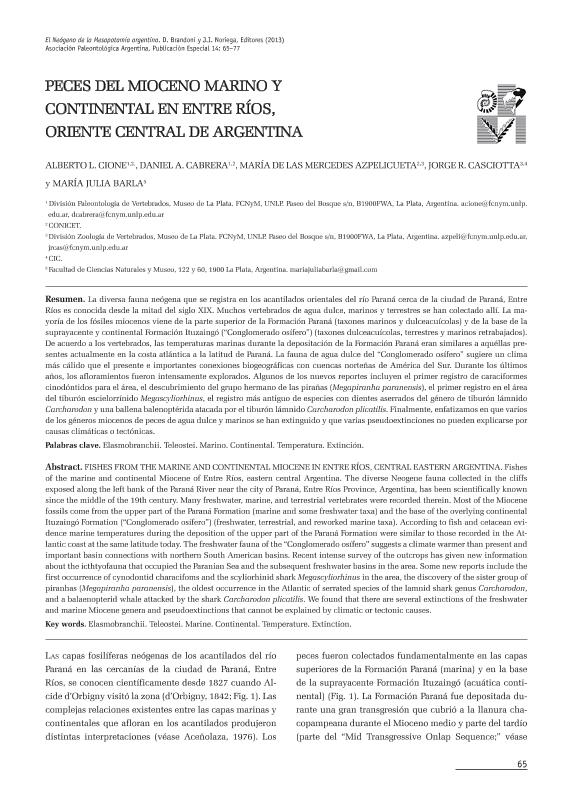Artículo
La diversa fauna neógena que se registra en los acantilados orientales del río Paraná cerca de la ciudad de Paraná, Entre Ríos es conocida desde la mitad del siglo XIX. Muchos vertebrados de agua dulce, marinos y terrestres se han colectado allí. La mayoría de los fósiles miocenos viene de la parte superior de la Formación Paraná (taxones marinos y dulceacuícolas) y de la base de la suprayacente y continental Formación Ituzaingó (“Conglomerado osífero”) (taxones dulceacuícolas, terrestres y marinos retrabajados). De acuerdo a los vertebrados, las temperaturas marinas durante la depositación de la Formación Paraná eran similares a aquéllas presentes actualmente en la costa atlántica a la latitud de Paraná. La fauna de agua dulce del “Conglomerado osífero” sugiere un clima más cálido que el presente e importantes conexiones biogeográficas con cuencas norteñas de América del Sur. Durante los últimos años, los afloramientos fueron intensamente explorados. Algunos de los nuevos reportes incluyen el primer registro de caraciformes cinodóntidos para el área, el descubrimiento del grupo hermano de las pirañas (Megapiranha paranensis), el primer registro en el área del tiburón escielorrínido Megascyliorhinus, el registro más antiguo de especies con dientes aserrados del género de tiburón lámnido Carcharodon y una ballena balenoptérida atacada por el tiburón lámnido Carcharodon plicatilis. Finalmente, enfatizamos en que varios de los géneros miocenos de peces de agua dulce y marinos se han extinguido y que varias pseudoextinciones no pueden explicarse por causas climáticas o tectónicas. Fishes of the marine and continental Miocene of Entre Ríos, eastern central Argentina. The diverse Neogene fauna collected in the cliffs exposed along the left bank of the Paraná River near the city of Paraná, Entre Ríos Province, Argentina, has been scientifically known since the middle of the 19th century. Many freshwater, marine, and terrestrial vertebrates were recorded therein. Most of the Miocene fossils come from the upper part of the Paraná Formation (marine and some freshwater taxa) and the base of the overlying continental Ituzaingó Formation (“Conglomerado osífero”) (freshwater, terrestrial, and reworked marine taxa). According to fish and cetacean evidence marine temperatures during the deposition of the upper part of the Paraná Formation were similar to those recorded in the Atlantic coast at the same latitude today. The freshwater fauna of the “Conglomerado osífero” suggests a climate warmer than present and important basin connections with northern South American basins. Recent intense survey of the outcrops has given new information about the icthtyofauna that occupied the Paranian Sea and the subsequent freshwater basins in the area. Some new reports include the first occurrence of cynodontid characifoms and the scyliorhinid shark Megascyliorhinus in the area, the discovery of the sister group of piranhas (Megapiranha paranensis), the oldest occurrence in the Atlantic of serrated species of the lamnid shark genus Carcharodon, and a balaenopterid whale attacked by the shark Carcharodon plicatilis. We found that there are several extinctions of the freshwater and marine Miocene genera and pseudoextinctions that cannot be explained by climatic or tectonic causes.
Peces del mioceno marino y continental en Entre Ríos, oriente central de Argentina
Título:
Fishes from the marine and continental miocene in Entre Ríos, central eastern Argentina
Cione, Alberto Luis ; Cabrera, Daniel Alfredo
; Cabrera, Daniel Alfredo ; Azpelicueta, Maria de Las M.
; Azpelicueta, Maria de Las M. ; Casciotta, Jorge R.; Barla, María Julia
; Casciotta, Jorge R.; Barla, María Julia
 ; Cabrera, Daniel Alfredo
; Cabrera, Daniel Alfredo ; Azpelicueta, Maria de Las M.
; Azpelicueta, Maria de Las M. ; Casciotta, Jorge R.; Barla, María Julia
; Casciotta, Jorge R.; Barla, María Julia
Fecha de publicación:
03/2013
Editorial:
Asociación Paleontológica Argentina
Revista:
Publicación Especial - Asociación Paleontológica Argentina
ISSN:
2469-0228
Idioma:
Inglés
Tipo de recurso:
Artículo publicado
Clasificación temática:
Resumen
Palabras clave:
Elasmobranchii
,
Teleostei
,
Marino
,
Continental
,
Temperatura
,
Extinción
Archivos asociados
Licencia
Identificadores
Colecciones
Articulos(CCT - LA PLATA)
Articulos de CTRO.CIENTIFICO TECNOL.CONICET - LA PLATA
Articulos de CTRO.CIENTIFICO TECNOL.CONICET - LA PLATA
Citación
Cione, Alberto Luis; Cabrera, Daniel Alfredo; Azpelicueta, Maria de Las M.; Casciotta, Jorge R.; Barla, María Julia; Peces del mioceno marino y continental en Entre Ríos, oriente central de Argentina; Asociación Paleontológica Argentina; Publicación Especial - Asociación Paleontológica Argentina; 14; 1; 3-2013; 65-77
Compartir



